Some public-sector RFPs can run well over 100 pages, packed with dense legal and technical language. No surprise then that many teams feel overwhelmed before the process even begins.
Learning how to create a request for proposal (RFP) with AI offers a way out, streamlining complexity into clarity and turning scattered inputs into polished, vendor-ready documents in a fraction of the time.
In this article, we will:
- Show you how to streamline RFP creation with AI step by step
- Provide ready-to-use AI prompts to speed up your RFP drafting
- Share quick fixes for common AI RFP challenges you may face
RFP creation with AI: Your complete implementation roadmap
Creating a Request for Proposal with artificial intelligence transforms what traditionally takes weeks into a streamlined process that can be completed in days. From initial platform setup to final distribution, you'll harness AI's full potential for your procurement needs.
Here's how to revolutionize your RFP creation process.
Step 1: Set up your AI RFP platform and knowledge base
The foundation of successful AI-powered RFP creation begins with selecting the right platform and establishing a comprehensive knowledge base. This initial setup phase determines how effectively your AI system will perform throughout the entire RFP lifecycle.
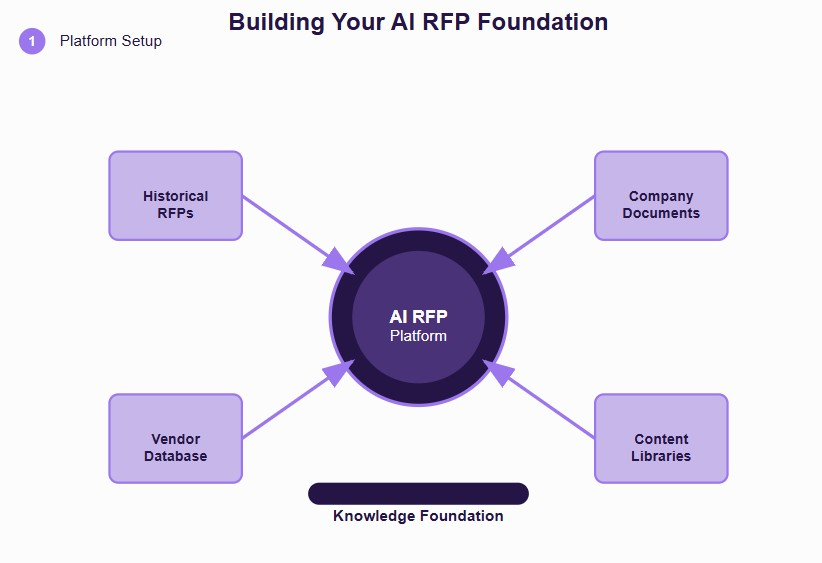
- Choose an AI RFP tool: Select from platforms like DeepRFP, AutoRFP.ai, or Inventive AI based on your needs
- Upload historical data: Import past RFPs, successful proposals, company documents, and vendor databases
- Configure company profile: Input company information, branding guidelines, standard terms, and compliance requirements
- Create content libraries: Build repositories of boilerplate text, technical specifications, and legal clauses
- Set user permissions: Establish team access levels and collaboration workflows
Pro tip: Start with a small pilot project using a pilot project plan template to test your platform before rolling it out organization-wide. This approach allows you to identify potential integration issues and optimize your setup without disrupting ongoing procurement activities.
Step 2: Define project requirements using AI analysis
Transform your project vision into structured requirements using AI's analytical capabilities. Modern AI tools can identify gaps in your initial requirements and suggest improvements based on industry best practices and historical data patterns.
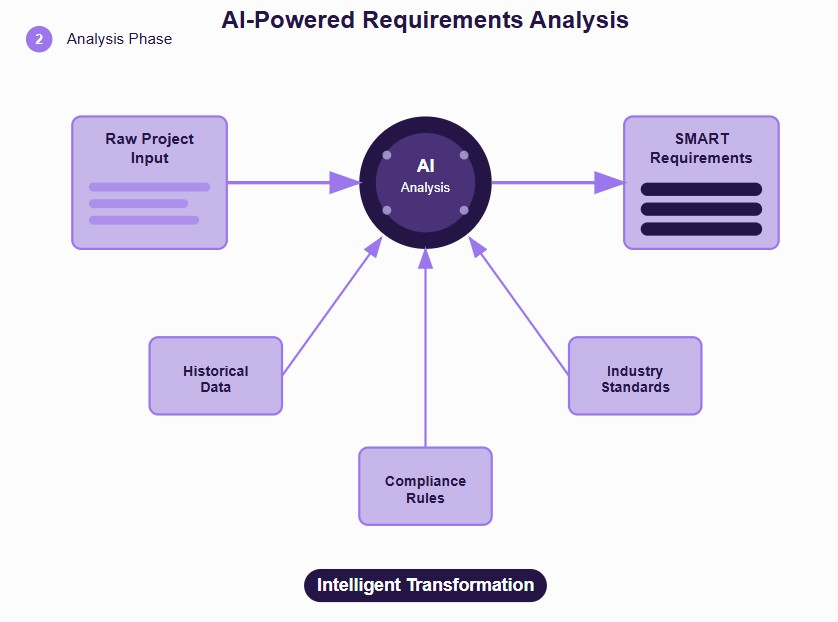
- Input project parameters: Enter project type, budget range, timeline, and key objectives into the AI system
- Generate requirement templates: Use AI to create SMART requirements (Specific, Measurable, Attainable, Relevant, Time-based)
- Analyze similar RFPs: Let AI review comparable past projects to identify missing requirements or best practices
- Create compliance checklist: Generate industry-specific regulatory and compliance requirements automatically
- Validate stakeholder needs: Use AI surveys or questionnaires in your IT project management system to gather comprehensive stakeholder input.
The key advantage here is AI's ability to cross-reference thousands of similar projects instantly, ensuring your requirements are comprehensive and aligned with industry standards. This eliminates the common problem of overlooking critical specifications that could impact project success.
Step 3: Generate RFP structure and content with AI
Watch as AI transforms your requirements into a professionally structured document, complete with all necessary sections and compliance language. This step showcases AI's ability to handle the time-consuming aspects of document creation while maintaining consistency and quality.
- Auto-generate RFP outline: Use AI to create document structure based on project type and industry standards
- Populate standard sections: Let AI fill in company background, general terms and conditions, and submission guidelines
- Create technical specifications: Use AI to convert requirements into detailed technical specifications and evaluation criteria
- Generate vendor questions: AI creates comprehensive questionnaires covering technical capabilities, experience, pricing, and compliance
- Insert legal and compliance language: Automatically populate necessary legal terms, data protection clauses, and regulatory requirements
Remember that AI excels at maintaining consistency across similar document sections while adapting content to specific project needs. This ensures your RFP maintains a professional tone and comprehensive coverage without the typical human oversight errors.
Step 4: Customize and refine with AI assistance
Fine-tune your generated content to perfectly match your specific project requirements and organizational standards. This step combines AI efficiency with human oversight to create truly tailored procurement documents.
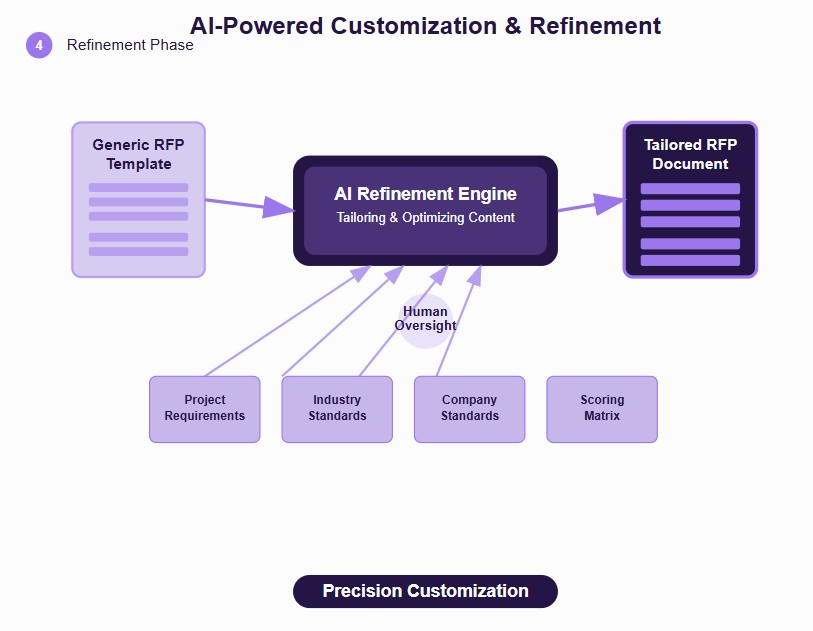
- Tailor content to project: Use AI to customize generic content for specific project needs and client requirements
- Optimize for clarity: Apply AI editing tools to improve readability, eliminate jargon, and ensure consistent tone
- Add evaluation criteria: Create weighted scoring matrices for technical, commercial, and compliance factors
- Include submission requirements: Specify format requirements, deadlines, contact information, and evaluation process
- Generate vendor qualification criteria: Define minimum requirements and preferred qualifications automatically
Example: If you're procuring software development services, AI can automatically adjust technical requirements, security protocols, and deliverable specifications based on your industry vertical and project complexity level.
Step 5: Review and finalize using AI quality checks
Ensure your RFP meets all regulatory requirements and internal standards through comprehensive AI-powered quality assurance. This crucial step prevents costly mistakes and ensures vendor responses will be comparable and compliant.
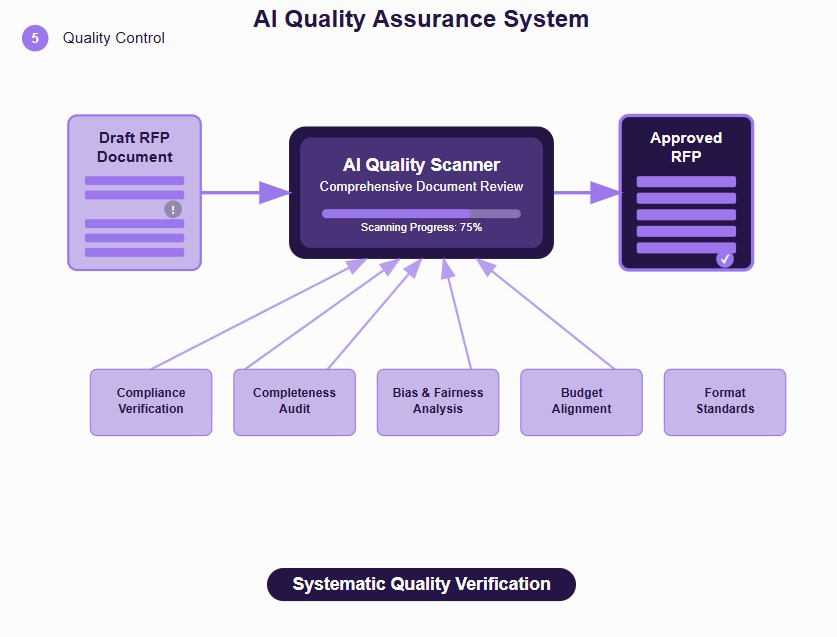
- Run compliance verification: Use AI to cross-check all requirements against industry regulations and internal policies
- Perform completeness audit: AI reviews for missing sections, unclear requirements, or contradictory information
- Check for bias and fairness: AI analyzes language for potential vendor discrimination or unfair advantages
- Validate budget alignment: Ensure requirements match allocated budget and timeline constraints
- Generate final formatting: AI applies consistent formatting, numbering, and professional presentation standards
The beauty of AI quality checks lies in their thoroughness and consistency. Unlike manual reviews that might miss subtle issues, AI systematically examines every aspect of your RFP against established criteria and best practices.
Step 6: Distribute and manage with AI automation
Streamline vendor outreach and ongoing communication through intelligent automation systems. This final step ensures your carefully crafted RFP reaches the right vendors while maintaining professional communication standards throughout the process.
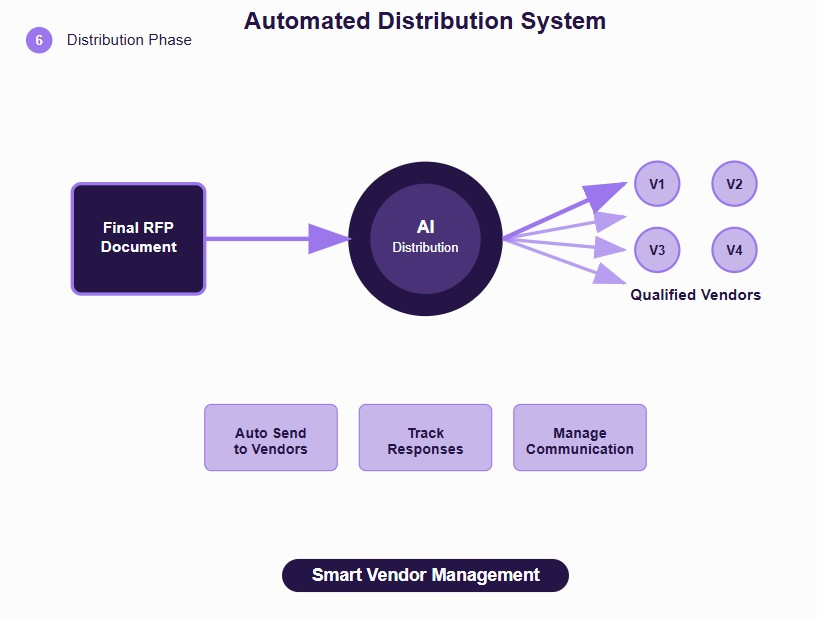
- Create vendor distribution list: AI identifies and qualifies potential vendors based on project requirements
- Automate RFP distribution: Send personalized RFP packages to qualified vendors through integrated communication systems
- Set up response tracking: Configure AI monitoring for vendor questions, clarifications, and submission status
- Enable automated responses: Program AI to handle routine vendor inquiries using pre-approved responses
- Schedule review milestones: Set up AI reminders for internal review deadlines and vendor communication touchpoints
Pro tip: Configure your AI system to automatically flag high-priority vendor questions that require human intervention, while handling routine inquiries automatically. This approach ensures important communications receive immediate attention while reducing administrative burden on your team.
By following these six steps, you'll transform your RFP process from weeks of manual work into an efficient, AI-powered system that delivers superior results.
Ready-to-use AI prompts: Your RFP creation toolkit
The difference between mediocre and exceptional AI-generated RFPs lies in the quality of your prompts. Having a well-organized prompt library transforms your AI tool from a basic writing assistant into a sophisticated procurement partner that understands your exact needs.
Essential prompt categories for RFP success
These core prompt types cover every critical aspect of professional RFP creation.
Scope definition prompts
Scope definition prompts help you articulate project boundaries and deliverables with precision. These prompts ensure your AI captures every critical requirement while avoiding scope creep that can derail projects later.
- "Create a comprehensive scope section for a [project type] with a budget of [amount] and timeline of [duration], including specific deliverables, milestones, and acceptance criteria."
- "Generate exclusions and assumptions for [project description] to prevent misunderstandings"
- "Define measurable success metrics for [specific service/product] procurement"
Security and compliance prompts
Security and compliance prompts automatically generate the protective language your organization needs. These prompts save hours of legal review while ensuring comprehensive coverage of regulatory requirements.
- "Create data security requirements for [industry] procurement, including encryption, access controls, and incident response protocols"
- "Generate compliance checklist for [specific regulation], ensuring vendor adherence to [standards]"
- "Write confidentiality and non-disclosure terms appropriate for [project sensitivity level]"
Legal and contractual prompts
Legal and contractual prompts produce professional language that protects your interests while maintaining vendor relationships. These prompts help you avoid common legal pitfalls without requiring extensive legal expertise.
- "Generate standard terms and conditions for [service type] with appropriate liability limitations and intellectual property protections"
- "Create payment terms and penalty clauses for [project duration] with performance milestones"
- "Write termination and dispute resolution language suitable for [contract value] agreements"
Adaptive prompting for different project phases
Specialized prompts for vendor evaluation and content refinement throughout your RFP lifecycle.
Vendor evaluation prompts
Vendor evaluation prompts create comprehensive questionnaires that reveal vendor capabilities beyond basic qualifications. These prompts help you identify the best partners rather than just the cheapest options.
- "Generate technical capability assessment questions for [specific expertise], including experience levels, tools, methodologies, and past performance metrics"
- "Create cultural fit evaluation questions to assess vendor alignment with [company values] and communication style"
- "Develop pricing structure questions that reveal the total cost of ownership, including hidden fees and ongoing expenses."
Clarity and refinement prompts
Clarity and refinement prompts transform complex technical language into clear, actionable requirements that vendors can easily understand and accurately price.
- "Rewrite this technical requirement in simple language while maintaining precision: [paste requirement]"
- "Identify potential ambiguities in this RFP section and suggest specific clarifications: [paste section]"
- "Convert these high-level objectives into specific, measurable requirements with clear success criteria."
Three drafting modes for different situations
Match your prompting approach to project complexity and organizational needs.
- Strict mode prompts: Create detailed, prescriptive requirements when you know exactly what you need. Use these for well-defined projects with clear specifications.
- Collaborative mode prompts: Invite vendor input and alternative approaches while maintaining your core requirements. Perfect for complex projects where vendor expertise can improve outcomes.
- Exploratory mode prompts: Encourage innovative solutions when you're open to different approaches. Ideal for emerging technology projects where flexibility drives better results.
Pro tip: Save your most effective prompts in a shared document with performance notes. Track which prompts generate the highest-quality vendor responses and refine them based on actual results.
Having this comprehensive prompt library at your fingertips transforms AI RFP creation from a trial-and-error process into a systematic, repeatable methodology that consistently delivers professional results.
Common AI RFP roadblocks: Quick fixes that actually work
Even the most sophisticated AI RFP platforms can hit unexpected snags during implementation and daily use. Understanding these common challenges and their proven solutions helps you maintain smooth operations while maximizing your AI investment's potential.
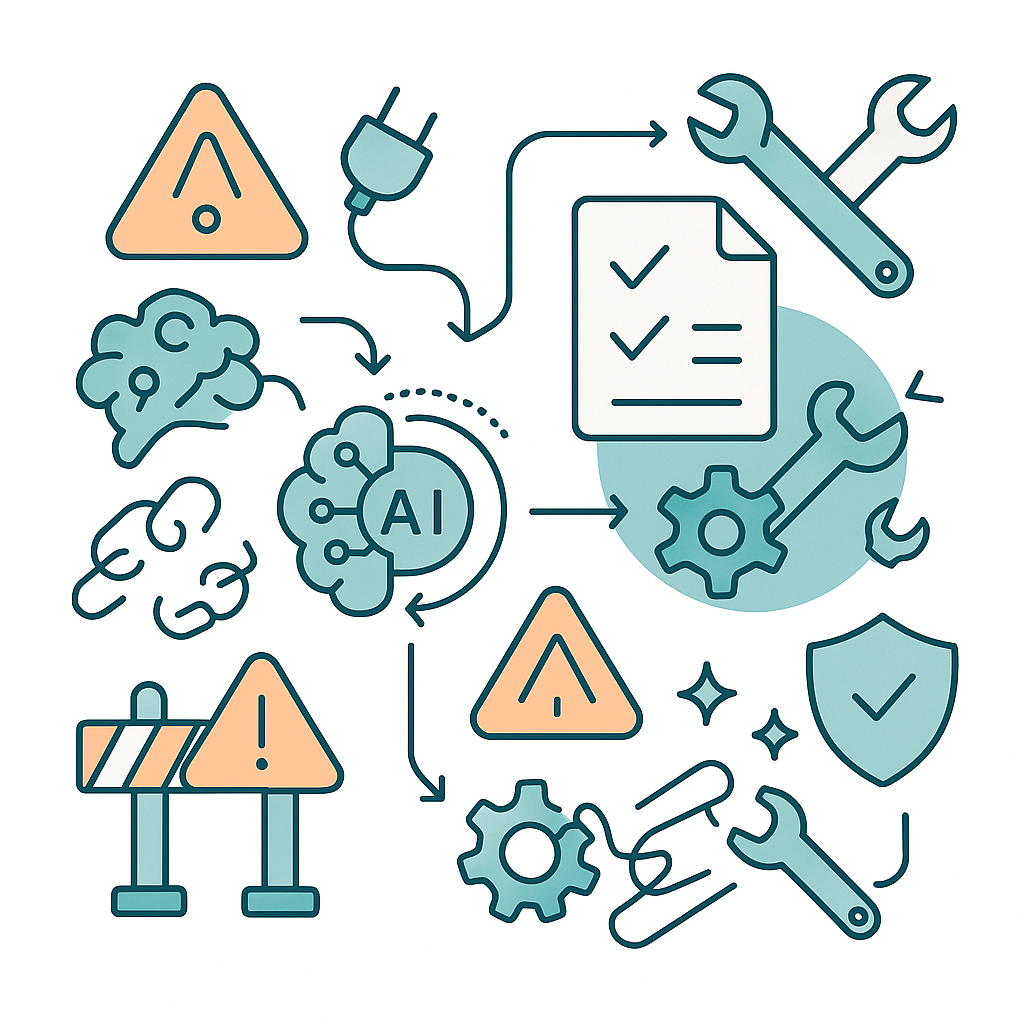
Inaccurate or irrelevant content generation
The problem: AI generates responses that don't match your company's expertise, include outdated information, or miss critical project requirements entirely.
Quick solutions:
- Audit your knowledge base regularly and remove conflicting or outdated documents
- Create specific content tags for different project types, industries, and compliance requirements
- Use feedback loops to train the AI on your preferred responses and writing style
- Implement human review checkpoints for critical sections before finalizing content
Most platforms allow you to rate AI responses and provide corrections, which improves future output quality significantly.
Poor integration with existing systems
The problem: Your AI RFP tool doesn't sync properly with CRM systems, document management platforms, or existing procurement workflows, creating data silos and manual workarounds.
Quick solutions:
- Map your current workflow before selecting an AI platform to ensure compatibility
- Use platforms with robust API capabilities for custom integrations
- Start with single-system integration and gradually expand to avoid overwhelming your IT team
- Implement middleware solutions if direct integration isn't possible
Pro tip: Most integration issues stem from inadequate planning rather than technical limitations. Invest time upfront in understanding your system requirements.
Inconsistent quality control and compliance gaps
The problem: AI-generated RFPs vary in quality, miss industry-specific compliance requirements, or fail to maintain your organization's professional standards consistently.
Quick solutions:
- Create standardized review templates that check for completeness, compliance, and quality
- Establish multiple review stages with different team members focusing on specific aspects
- Use AI-powered compliance checking tools as a secondary verification layer
- Maintain updated compliance checklists for different industries and project types
- Set up automatic alerts for missing required sections or non-compliant language
The key is creating systematic quality gates rather than relying on ad-hoc reviews that might miss critical issues.
Team resistance and adoption difficulties
The problem: Team members struggle to adapt to new AI workflows, prefer traditional methods, or lack confidence in AI-generated content quality.
Quick solutions:
- Start with pilot projects using enthusiastic early adopters before full rollout
- Provide hands-on training sessions focusing on practical benefits rather than technical features
- Create success stories and metrics showing time savings and improved outcomes
- Allow a gradual transition by letting users choose when to apply AI assistance
- Establish clear protocols for when human oversight is required vs. when AI can work autonomously
Remember: Most resistance comes from fear of job displacement rather than the technology itself. Emphasize AI as an assistant that enhances human capabilities rather than a replacement.
Budget overruns and unexpected costs
The problem: Hidden fees, integration costs, or longer implementation timelines exceed initial budget projections.
Quick solutions:
- Request detailed cost breakdowns, including setup, training, and ongoing subscription fees
- Factor in internal resource costs for training and integration activities
- Start with basic features and scale up gradually rather than implementing everything at once
- Negotiate pilot periods or money-back guarantees to reduce financial risk
By addressing these challenges proactively, you'll avoid common pitfalls and ensure your AI RFP implementation delivers the promised efficiency gains and quality improvements.
Turning weeks of manual drafting into days with AI
RFPs no longer need to be drawn-out, error-prone documents. By leveraging AI for setup, requirement gathering, drafting, and distribution, you transform the process from weeks of effort into a streamlined workflow completed in days.
With prompt libraries, quality checks, and automation, your team gains consistency, speed, and compliance. The key is balance, let AI handle the heavy lifting while you focus on strategy and oversight. Done right, AI turns raw notes into polished, vendor-ready proposals that drive better procurement outcomes.


%20(1).jpg)
_light%201.png)





